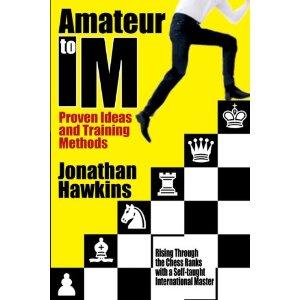
Amateur to IM Preview
*Please be warned, this is part article, part shameless book plug*
Hey guys this is IM Jonathan Hawkins from England.
My book 'Amateur to IM' was published last month, where I discuss some of the study material I worked on over the last 7-8 years in going from enthuisatic amateur to titled player. Chess.com seemed the perfect platform to give the chess community a sneak preview of some of the material I give.
The subject of this article is planning, with a little twist. No grand plans, no long term strategy, just what I call 'little plans'. Small incremental goals which are regularly reassessed and new goals made.
The reasons for this are clear: firstly the opponent can take many different paths so we constantly need to update our plans. Secondly, the goal of winning the game is usually too distant to visualise in any useful way. It is more useful to visualise ways to improve our position and damage our opponent’s position. Through repeated application of this we can hope to build up a winning advantage.
You will see how this works when we look at the example. I chose this topic because it works quite well as a self-contained lesson even if you decide not to read the book.
Let us dive into a game. It is my game with Nigel Short from the 2011 British Championships. This game was awarded 'best game' prize at that event, the 2nd year in a row I have been on the wrong side of that prize. I seem to have an ability for losing brilliantly.

Me smiling for the camera
After being move-ordered in the opening into a line where my knowledge was fairly poor, I was moderately pleased to have reached what appeared to be a fairly level position. Surely with my strong (or so I thought) central structure and reasonably placed pieces I would not be in any danger...
However the difficulties of playing without a plan against an (admitted much stronger) opponent with a clear plan made this an unpleasant experience.
What does 16...h6 do?
Plan A:
- Force a concession from white with an eventual g6-g5 break.
- If white captures then the h2 weakness will become exposed, allowing black to capture on f4 will create a host of new weaknesses.
Notice the ‘reflex’ 16…h5 has no function here, and in fact ends all of black’s counterplay, there is no pawn which came come to g4 to kick away the knight.
With stage 1 complete, a7-a5 begins black's next plan...
Plan B: fix the white b-pawn as backward with the move a7-a5. Following this with a rook transfer to b6 (and later b4) to optimize one rook and put pressure on the b2 pawn (this can be increased with Be7-f6).
Again it seemed the crisis was over, clearly black has improved his position over the past few moves, but still everything is defended again and there is no clear path to victory for black.
Time for a new plan? This time it is more difficult but...
Plan C:
- White is paralysed, so without a clear breakthrough it is best to simply optimize the black pieces.
- The Rd8 can go to h8 (then maybe h4) black bishop to f6, and the black king can think about encroaching on the dark squares with Kc7-d6-c5.
After some toing and froing to reach the time control black needs to develop a new plan. It seems black cannot improve his pieces any further (unless he wishes to play Ka3 and possibly Ka2, although it is not clear what this achieves). Black develops a strong idea:
Plan D:
- Play the pawn break b7-b5 which forces the capture on b5. Recapture with the king and then return the king to its optimal post on b4.
- This has two possible ideas:
- To create passed pawns with c6-c5-c4.
- To open a route to improve the black rook further by bringing it to c5. After this black may be able to occupy c3 with a piece to tie down white further and weaken his protection of the b3 pawn.
The next lot of progress has been made. What is next?
Plan E:
- Optimize the king further with Ka3-b2.
- This will also give additional opportunities for the black rook potentially on c3,c2 or c1.
The final position is completely lost because 67.Rxc3+ dxc3 or 67.Bc4 Rxd3 68.Bxd3+ Kxb3 and black wins easily.

In good spirits after 7 hours of pain
Postscript:
After my game with Short, I found a game he had played 18 years previously which followed a very similar path. Previous experience of a position or structure and the plans associated with it is a key component of chess strength and gives the possessor a huge advantage.
Summarising our work today:
- A grand plan is a good thing, the move by move specifics are dealt with in the framework of little plans to achieve short term goals.
- Remember always that whilst the direction of travel (where you want to take the position) is determined by your plans, tactics are always present and form the pathways which you can take to your destination.
That's all for now folks. Take care and good luck in your games. If you want to check out my book you can find details at: http://mongoosepress.com/index.php?option=com_content&view=article&id=146:amateur-to-im&catid=1




